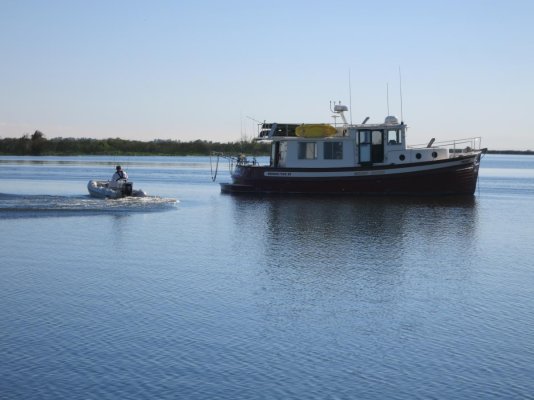I've seen the butterfly arms with closed fists on the hip sign language.
^^^ Bitch wings. Anchoring 101.
Start with your ground tackle. If it's robust, good. If it's marginal, make it robust. We started with a knockoff claw and a Delta Quickset. They both sucked. Some sailboter now has the claw, the Delta is still hanging in the #2 spot, used it twice in 11 yrs. The claw was replaced with a Rocna 33 kg. Best money we ever spent. 400 ft of 3/8" chain. Bigger IS better. Comfortable anchoring starts with confidence in your tackle.
Anchor with adequate scope - as if you might have a 40 kt squall. Nothing beats trying to re-set an anchor in a surprise thunderstorm at 3 in the morning because you didn't do it right the 1st time.
Set an anchor perimeter or an anchor watch on a chartplotter. I like to set a boundary circle in Coastal Explorer that's 10 or 20 ft. beyond my anchor scope. It's a good reference point if it gets blowy and things seem to be moving. It will be valid even in tidal swings as long as you center it on the anchor.
Don't anchor in front of another boat, unless there's adequate room. Prefer to anchor astern of them. Be mindful of the other vessels' scope. Ask them if you can't be sure. A friendly "how much scope do you have out?" shows you're courteous and careful, and helps to remove some of that territorial posturing. Smile, and "thanks!!"
It's very disarming to a boater who's doing the bitch wings when you approach them with a smile and ask for advice. They were a newbie too. And maybe more recently than you might imagine.
Avoid anchoring near the "harbor sweeper"- the guy in 10 ft of water with 200 ft of chain out. There's no salvation for that guy, just go elsewhere and let him yank some other boater's anchor out.
Leave EARLY in the morning. Arrive at the next anchorage early, then YOU can get a perfect spot then stand on the bow and do the bitch wings as the stragglers come in and try to crowd you!





